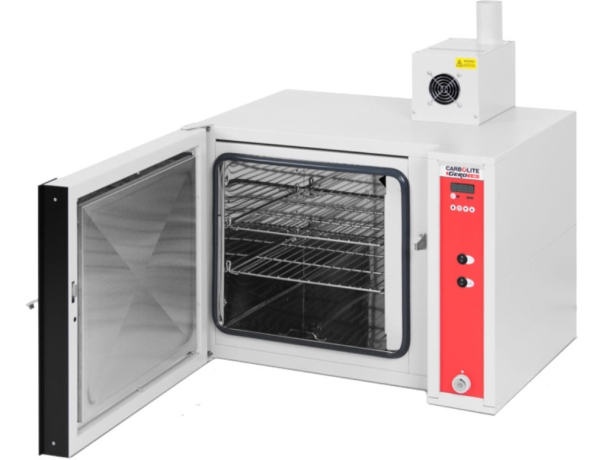The main use of laboratory ovens includes thermal convection applications involving large volumes. Typically, these ovens maintain a constant temperature during the whole procedure. The majority of sectors use lab ovens, including transportation, healthcare, technology, etc. Lab ovens may be used for die-bond curing, natural convection, annealing, polyimide baking, horizontal airflow, drying, as well as other industrial laboratory applications.
These are the various Kinds of lab ovens:
- Forced air oven
- gravity convection ovens
- Natural convection laboratory ovens
- Clean Room Oven
Laboratory ovens are usually used for solvent removal, glassware drying, sample testing, annealing, evaporation of samples, polymer curing, etc.
Working principle of lab ovens:
The convection principle is used by a laboratory oven for warming its contents. The oven's heating element is positioned outside of the specimen chamber in a separate exterior enclosure. This protects against heat and radiation. For drying and heating, the temperature that the oven walls attain is sufficient. The advantage of the furnace is that it is made of steel, which helps avoid radiation of heat from the oven's outside. The oven chamber is accessible through a door with a locking mechanism and sturdy gaskets.
Convection, either mechanical or gravity, is used to accomplish convective heat transfer. In gravity convection, the warm air displaces the cool air. Then it is directed to the heating element till t° is attained by the entire chamber. Mechanical convection lab ovens are usually preferred over gravity convection ones because of the non-uniform distribution of heat, time-consuming preheating and wastage of energy. Due to blowers as well as the baffles in the oven chamber, the mechanical convection heats more quickly and uniformly.
There are three fundamental roles of a laboratory oven which are: drying, baking and curing.
The majority of medical, research and forensic labs use lab ovens for drying and conventional heating purpose.

How are lab ovens built?:
Energy Efficient:
The heating of a laboratory oven's chamber demands a significant amount of energy. To shorten preheating times, it is a standard practice to leave ovens on for extended durations. The shell of the oven is made up of steel and layers of insulation to avoid and reduce thermal transfer. Reducing thermal escape from the oven may result in reductions in cost. To reduce the operating periods, ovens with a boost function use an accelerated preheating process.
Temperature:
The oven chamber should maintain a consistent temperature throughout. A range in temperature of just above ambient - 300°C is maintained by most laboratory ovens. The technology of PID control, thermostat, and proportional control is used for temperature regulation.
Controlled Atmosphere
A few lab ovens can work with apparatus that introduces a particular gas/gas compound in the chamber or eliminates the chamber's atmosphere entirely.
Space:
A lot of importance is given to the volume and installation of the oven. The interior cubic capacity of the chamber of the oven must fit the spatial requirements of the substrates. It should also be able to fit in as much as samples as possible in a single cycle of the oven itself. Laboratory ovens are available in three mounting types, namely, benchtop, cabinet and walk-in.
Muffle Furnace
A muffle furnace is a piece of high-temperature oven-like equipment. Typically, a heating coil with a high temperature is encased in an insulating substance. The insulating substance efficiently prevents heat from escaping by acting as a muffle. The word muffle furnace could also refer to an oven with a long, broad, and narrow hollow tube that is utilized in roll-to-roll production. Typically, there is no combustion involved in the system's temperature regulation, which enables far better control over temperature uniformity and ensures isolation.
Enhanced heating element materials allow for more advanced metallurgical applications. Its common applications involve high temperatures, such as ceramics, brazing, soldering, developing enamel coverings, and fusing glass.
Types of Muffle Furnace
information:
●Variety of Maximum temperatures.
● High-quality, ecological thermal insulation material.
● Low power consumption.
● Short heating up/Cooling down period.
● High degree of accuracy.
●Digital temperature controller.
Economy Chamber Furnaces 3-80 liters
1,
8 LITER 1100 DEG C Muffle FURNACE
Maximum temperature 1100 deg c
Volume 8 liter
Internal chamber:w180mm*h135mm*d250mm
2.
13 LITER 1100 DEG C LABORATORY MUFFLE FURNACE
Maximum temperature 1100 deg c
Volume 8 liter
Internal chamber:w225mm*h180mm*d360mm
External dimensions:w500*d700*h550mm,38kg
3.
22 LITER 1100 DEG C LABORATORY MUFFLE FURNACE
Maximum temperature 1100 deg c
Volume 22 liter
Internal chamber:w275mm*h155mm*d500mm
External dimensions:w600*d890*h610mm,58kg
